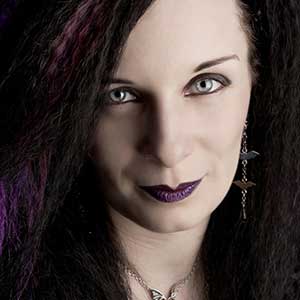White Moth Black Butterfly on the joys of making "happy music"
How TesseracT’s Daniel Tompkins braved sadistic midges, toxic fumes and self-sacrifice to find atonement at the end of the rainbow with White Moth Black Butterfly

“The midges in Scotland are fierce – they destroyed us!” Daniel Tompkins laughs as he reveals one of the menaces of the beautiful British countryside, where he was being filmed for his experimental project White Moth Black Butterfly.
“Our director had 130 bites on his body!” he adds, his voice lifting in amazement.
It’s a warm and dry afternoon when the TesseracT vocalist lets Prog in on the secrets behind the rain-soaked sets in the mock medieval village of Duncarron, near the lush Loch Lomond. Not only did the videos for Tempest and Evelyn result in him working with the team at Dark Fable Media – they’ve previously filmed the likes of Devin Townsend and Ihsahn – but they also mark a new multimedia era for the project. And fans are already referring to the diptych as a cross between Game Of Thrones and The OA.
“Me and Jordan [Bethany, co-vocalist] did a performance inside the longhouse,” he says. “There were three braziers burning within this confined space so we were getting choked for at least three or four hours – it was quite hardcore. We had to break every few minutes to dry our eyes because we were crying from the smoke. We were filming on the land, in the forest, by the rivers – doing anything we could to get the right shots. My and Jordan’s feet were sodden after an hour and we were there for two days, but we got some amazing footage. The last shot we did was this epic fight scene. There was a break in the rain and a big rainbow came out. It was unbelievable.”
The two-part storyline follows Tompkins and Bethany through their quest to save the soul of a fictional village, which results in their on-screen deaths. The prog-friendly productions are far bigger and more ambitious than anything the pair have done before, so to suggest the singer is excited would be a massive understatement.
The battle scenes and interpretative dance rituals they filmed are a far cry from his other band’s very modern videos, but then again, the free-spirited White Moth Black Butterfly are very different from TesseracT.
Tompkins has enjoyed an eclectic career so far. Before becoming a full-time singer and vocal coach, he was a police officer, and it was during this period that he first started dabbling in the solo project that became WMBB. Back in 2009, it was little more than a light-hearted creative outlet, albeit one that would allow him to experiment musically and learn how to use music production software.
Sign up below to get the latest from Prog, plus exclusive special offers, direct to your inbox!
WMBB also filled the creative void between him leaving post-hardcore band First Signs Of Frost and first joining djent newcomers TesseracT. But the project soon evolved into a collaborative effort when he began writing with Indian musician Keshav Dhar. (Tompkins was also in Dhar’s own band Skyharbor for several years.)

The result was WMBB’s self-released One Thousand Wings in 2013. It was an album that fused trip-hop, experimental electronica and shoegaze, and won the pair a new fan base. They played three intimate shows that autumn, and released the single Rising Sun via Bandcamp the following spring. But after Tompkins rejoined TesseracT in 2015, the project seemed to flutter away.
Four years on from their acclaimed debut, WMBB are back with the cinematic Atone. This second album finds Tompkins and Dhar reconnecting with guest vocalist Bethany, and teaming up with Devin Townsend Project/Casualties Of Cool producer Randy Slaugh. Across 11 tracks, the studio-based quartet explore themes of faith, hope, forgiveness and loss, although the vocalist avoids divulging the exact meanings of specific songs.
“I wouldn’t say the themes are a reflection of how I was feeling,” says Tompkins from his home studio in Nottinghamshire. “I wasn’t in a sad or dark place – I’m feeling very happy actually – but the music I create has an element of sadness to it. Music is a powerful tool – I’ve always liked material that has an underpinning of hope and takes you on a journey, and when I listen to Atone now, there’s a feeling of nostalgia throughout it.
“With technology and politics, how people interact with each other is quite apathetic, and I think back to how things were when we had very little and perhaps cared a bit more about each other. I think that’s one of the reasons I wanted to do a historic music video, so I could dip into that a bit more. But there are also a lot of love songs on the album too…
“I haven’t got anything negative to sing about now, but I used to. In my younger days, I was a very bitter person. I think on the first TesseracT album [One], you could hear I had a lot of issues I wanted to get off my chest, but now it’s very hard to write anything other than happy music.”
Recorded across India, the USA and the UK, Atone moves WMBB’s sound away from their synthetic-sounding debut and into a much grander space. Inspired by the likes of Sigur Rós, Tool, North Atlantic Oscillation and Enigma, it takes the listener on a journey, ebbing and flowing through folkish elements and trip-hop nuances. It’s thoughtful with a melancholic edge, enhanced by the addition of elegant harps, cellos, a French horn and even a pipa, a type of Chinese lute. There are additional guest vocals from classical singer and fellow voice coach Amanda Munton, and dramatic samples that send the project soaring to even more dynamic heights.
“One of the songs, II: Penitence, has a very folky, soft vocal,” Tompkins reveals. “But at the end of the string part there’s a soundscape from World War II, with the sounds of people marching and weapons being fired. It’s a very evocative song and there’s a lot of that about the album. There are very low, brooding moments that blossom into colourful vocal‑led songs.
“I know it sounds cheesy but it’s like a dreamscape. I want people to plug in, listen from the start and go off on a journey right the way through, rather than just have an album of songs. I think we’ve achieved that and I think we’ve found our sound in Atone. It’s not an album you’ll get bored listening to. It’s experimental but it’s also very accessible in areas – the balance was hard to find but I think we’ve got it.”
Although he cites Enigma’s New Age-influenced MCMXC aD as a major inspiration, Tompkins’ and Dhar’s musical vision feels far more organic and contemporary. Add Randy Slaugh’s instrumental arrangements and the results are seriously impressive.
The project’s new deal with Kscope, the same label that TesseracT are on, has given them further excuses to think big. Outside their work in the progressive world, both Slaugh and Dhar score films, and that’s a direction Tompkins would like to see WMBB move in. He confirms that the two promotional extravaganzas released so far are just a glimpse of his hopes and dreams.

“I’d like to have an album that’s accompanied by a film in the future,” he says. “The music really does lend itself to that type of thing. Because White Moth is a studio project, one of its strengths is the visuals, and I think it’s an exciting prospect to have an album accompanied by visuals. I’ve always had a big plan for us and in the next five years I would like to have released another couple of albums and played in the live arena with a proper production. We’ll see where this takes us.”
Now Atone is finally out, Tompkins has turned his attention back towards TesseracT. The progressive metal five-piece are currently working on the follow-up to 2015’s Polaris, which is tipped for release early next year. With the singer also involved in the synth‑pop studio project Zeta – their self‑titled debut was released in June – there’s a risk he could be spreading himself a little thin. However, he says, that’s something he’s making sure doesn’t happen.
“Before I rejoined TesseracT and on the second Skyharbor album [2014’s Guiding Lights], I felt like I had diluted myself a little bit so I began to rein things back,” he admits. “When I initially left TesseracT [in 2011], I felt like I had a very uncertain future. I took a big leap of faith in leaving the police force and doing music full-time so I lent my voice to as many projects as possible to keep a presence.
“In the last eight years, I think I’ve released 14 albums with various different bands… but now I have one progressive metal project, one experimental and another outlet for pop. I would never do more than that and, to be honest, I feel like I’m a bit stretched anyway.”
If Atone is anything to go by, perhaps a little stretching is a good conductor of Tompkins’ creativity. But will it be another four years before White Moth Black Butterfly take flight again? And can they really achieve Tompkins’ big dreams? Only time can tell.
Atone is out now via Kscope. See www.facebook.com/whitemothblackbutterfly.
White Moth Black Butterfly - Atone album review
Worlds Apart: What happened when Tesseract went to South Africa

Contributing to Prog since the very first issue, writer and broadcaster Natasha Scharf was the magazine’s News Editor before she took up her current role of Deputy Editor, and has interviewed some of the best-known acts in the progressive music world from ELP, Yes and Marillion to Nightwish, Dream Theater and TesseracT. Starting young, she set up her first music fanzine in the late 80s and became a regular contributor to local newspapers and magazines over the next decade. The 00s would see her running the dark music magazine, Meltdown, as well as contributing to Metal Hammer, Classic Rock, Terrorizer and Artrocker. Author of music subculture books The Art Of Gothic and Worldwide Gothic, she’s since written album sleeve notes for Cherry Red, and also co-wrote Tarja Turunen’s memoirs, Singing In My Blood. Beyond the written word, Natasha has spent several decades as a club DJ, spinning tunes at aftershow parties for Metallica, Motörhead and Nine Inch Nails. She’s currently the only member of the Prog team to have appeared on the magazine’s cover.
